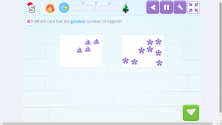Number Sense
When speaking about mathematics most people think it is the ability to count, add and subtract numbers, or the ability to solve complex math equations. But, what comes before counting and the ability to recognize numbers? Number sense! In other words, the primitive ability to recognize and represent amounts without using numerical symbols (Dehaene, 2011).
Children Are Born with Innate Math Abilities
It’s snack time! You offer your one-year-old nephew two cookies, but he immediately sees that you have had three and he makes a fuss. How is this possible if he still does not know how to count? Scientific studies confirm that from the age of six months children can discriminate between small numbers (Feigenson et al., 2002).
And that’s not all! Before babies are able to speak, they can also discriminate between larger quantities, as long as the difference between both numbers is clear (for example, 20 and 10). The ability that babies have to discriminate between quantities is also replicated using sounds and actions which indicates the existence of a mental mechanism that represents quantities in infancy independent from the type of stimulus presented (verbal vs visual). We have seen six-month-old babies who can discriminate between a series of 8 versus 16 sounds (Lipton and Spelke 2003) or between two versus three jumps made by a puppet (Sharon and Wynn,1998).

Subitizing and the Approximate Number System
On one hand, we are talking about subitizing, which is the automatic and immediate recognition of small sets of elements. And on the other hand, we find the approximate numerical system, which is the ability to perceive and discriminate between large quantities without counting.
This ability to recognize and manipulate numerical amounts without counting is present from birth, but with age, it develops and becomes more and more accurate.
Different studies have shown that number sense is an important precursor of learning mathematics (Starr et al., 2013). For example, if we evaluate subitization and the approximate number system in early childhood, we know that these skills predict the math performance of children in first and second grade (Mazzocco et al., 2011). Therefore, the numerical sense can be considered as primitive basic knowledge that supports the development of the concept of numbers and general math skills.
In addition to the importance of these skills, it has been shown that children with dyscalculia have problems in the representation and manipulation of quantities (Piazza et al., 2010; Ashkenazi et al., 2013). Furthermore, these problems predict their difficulties in tasks involving the manipulation of symbolic numbers.
Can You Train Number Sense?
Given the importance of numerical sense for the development of advanced mathematical skills, some scientific studies have focused on researching the effectiveness of a program designed to improve preverbal numerical skills in children. These studies show that it is possible to train the numerical sense in preschool age (Van Herwegen et al., 2017) and in primary school-age children (Hyde et al., 2014). In addition, the positive effect of quantity-focused training programs is also reflected in an improvement in children’s formal math skills, such as counting and arithmetic.
It is important to take these interesting results into consideration when it comes time to choose activities to include in a math curriculum in the early years of formal education.
References:
- Ashkenazi, S., Mark‐Zigdon, N., & Henik, A. (2013). Do subitizing deficits in developmental dyscalculia involve pattern recognition weakness?. Developmental Science, 16(1), 35-46.
- Dehaene, S. (2011). The number sense: How the mind creates mathematics. Oxford, England:
Oxford University Press. - Feigenson, L., Carey, S., & Hauser, M. (2002). The representations underlying infants’ choice of more: Object files versus analog magnitudes. Psychological science, 13(2), 150-156.
- Hyde, D. C., Khanum, S., & Spelke, E. S. (2014). Brief non-symbolic, approximate number practice enhances subsequent exact symbolic arithmetic in children. Cognition, 131(1), 92-107.
- Lipton, J. S., & Spelke, E. S. (2003). Origins of number sense: Large-number discrimination in human infants. Psychological science, 14(5), 396-401.
- Mazzocco, M. M., Feigenson, L., & Halberda, J. (2011). Preschoolers’ precision of the approximate number system predicts later school mathematics performance. PLoS one, 6(9), e23749.
- Piazza, M., Facoetti, A., Trussardi, A. N., Berteletti, I., Conte, S., Lucangeli, D., … & Zorzi, M. (2010). Developmental trajectory of number acuity reveals a severe impairment in developmental dyscalculia. Cognition, 116(1), 33-41.
- Sharon, T., & Wynn, K. (1998). Individuation of actions from continuous motion. Psychological Science, 9(5), 357-362.
- Starr, A., Libertus, M. E., & Brannon, E. M. (2013). Number sense in infancy predicts mathematical abilities in childhood. Proceedings of the National Academy of Sciences, 110(45), 18116-18120.
- Van Herwegen, J., Costa, H. M., & Passolunghi, M. C. (2017). Improving approximate number sense abilities in preschoolers: PLUS games. School Psychology Quarterly, 32(4), 497.
Learn More:
- What is Subitizing and How to Improve It
- The Importance of Finger Counting
- Tens and the Decimal Number System
- Mental Math Strategies for Children
- Transcoding Numbers
- Mistakes: An Opportunity to Learn - 05/07/2020
- The Importance of Positive Reinforcement in Education - 04/02/2020
- Is It True That Boys Are Better at Math Than Girls? - 03/05/2020







